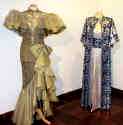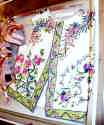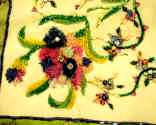Baby’s jacket, c. 1750
(You can’t imagine how small that jacket is – was certainly made for a newborn baby)
Jupe à la Francaise and Robe à la Francaise
Watch the „patching“ at the collar of the gown in the close-up – what might have been patched there, in a place which would usually be hidden by a stomacher?
The stomacher is missing and the front lacing is visible. The baby jacket from above, by the way, can be seen next to the gown on the floor on the right side.
Another interesting detail is the button embroidery on the Jupe, also visible in the detail picture.
Waistcoat
An unfortunately considerably damaged waistcoat (the silk is ’shredded‘, which it does if it’s old and was treated badly at some point of time)
„Fine“ dresses from 1900-2000
Jacket of buttons
On the left hand side you can see a picture of the person who owns this jacket…
Perhaps a nice idea for you if you should have a massive amount of different buttons but so far had no clue what to use them for…?
A gown made of ties
Well, I also had that idea at some point of time (and still have a large amount of ties in a box at my home…) The model displayed at that particular exhibit was not so very well made – unfortunately. I especially dislike the horizontal waist seam, which isn’t really necessary when making such a gown.
Vest by Emilio Pucci
The Italian designer Emilio Pucci is – right next to Joseph Ribkoff (from Canada) and Thierry Mugler from France – one of my favorite modern designers. However, in contrast to Ribkoff, of whom I already have some garments, I couldn’t yet afford one of the old works of Pucci. Observe that incredible beading!
Dolls
Some dolls of times long gone were also on display at the museum.
Paintings
Of course, the museum also had some paintings – masses of wonderful, in some cases giant paintings from past centuries as well from a special exhibit that displayed „The art in the time of the Nazi regime“, which I also found interesting.
Here’s a selection:














